Domestic Sustainable Energy, Part 2
Last time I talked in some depth about solar PV and the smart/lucky decision we took back in 2011 to install a 3.6kWh system on our house.
In this second part I’m going to share some data on the impacts of our investments and why we opted to invest even more in doubling the size of our system.
Don’t forget to refer back to Part 1 if any of the terminology is unfamiliar.
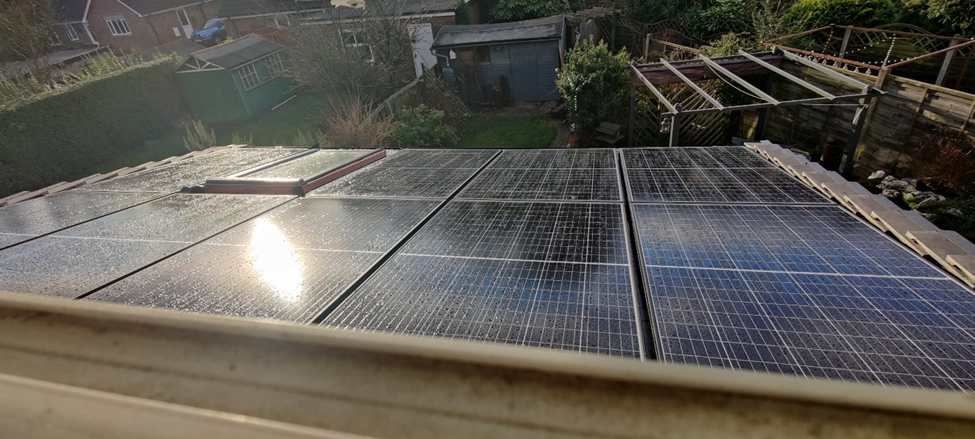
There is something ridiculously addictive about solar PV.
For several years, until we had a smart meter installed, on sunny days we would pop out to look at our old electricity meter to watch it actually going backwards. While the Smart Meter put a stop to that bit of fun, the upside was that it enabled easy access to our usage data.
In late 2019 we had an Air Source Heat Pump (AHSP) installed to run our central heating; as expected we saw our electricity consumption leap, while our gas usage tumbled. Then in September of 2020, we bought ourselves a rather excellent EV, which also demanded more electricity. As the chart shows, we now use just 10% of the gas our neighbours consume (gas only provides our hot water, mostly showers), but slightly more than double the electricity. It actually works out at 12,200kWh less gas, 5,040 kWh more electricity for a net saving of 7,160 kWh purchased energy that year. Since we source all our electricity from ‘green’ sources our CO2 emissions are much improved, which is important. (Analysed using the Carbon Co-op Energy Impact Tracker https://hub.carbon.coop/impact-tracker/)
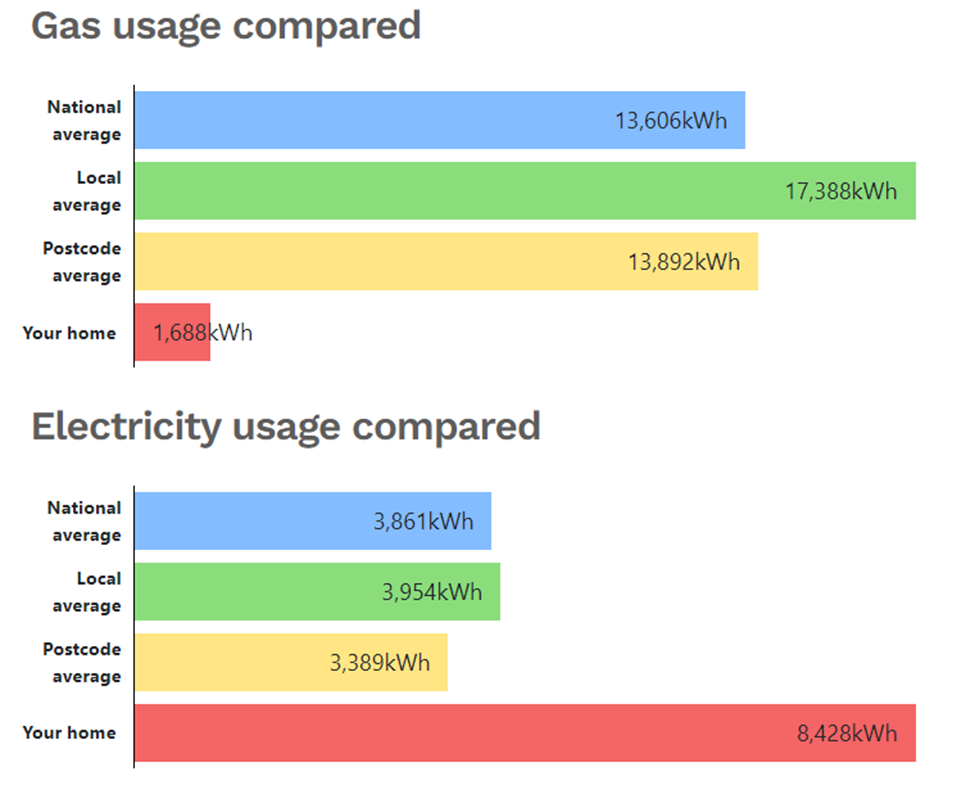
2021 Energy Impact (https://hub.carbon.coop/impact-tracker/results/a2b55a39-6c1f-4d5a-bac8-3a1b03814069/)
We were quite chuffed, but also conscious that we were still buying a lot of electricity, driven mostly by the ASHP and the car, since we had already made significant inroads into reducing the rest of the consumption in the house. We had looked at adding more panels to our existing system a few times but the best we could hope for was 2 more panels on the main roof. We couldn’t use our conservatory roof since it had a complex hipped-roof unsuitable for fitting panels. And then that roof started leaking…
And then that roof started leaking…
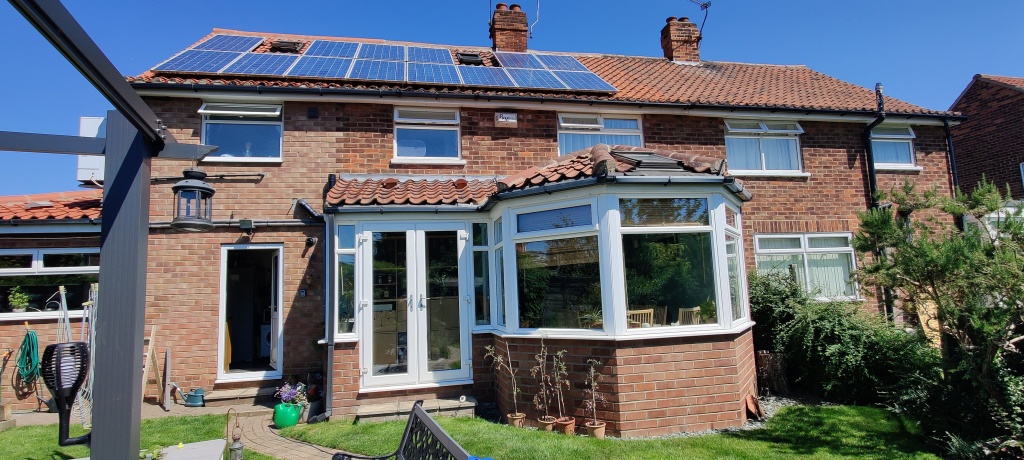
Designing for more solar
We tried to seal the existing conservatory roof a few times, without success, spending some hundreds of pounds in the process. A reroof was needed. As we planned this with our builder, we realised that we could redesign the whole roof to make it flat and therefore suitable for panels. Sam, our contact at Oval Renewables, suggested we could fully integrate the panels into the roof. In-roof panels meant skipping the whole tile things, weatherproofing the roof entirely using panels (apart from 1 run of tiles at either end). Long story short: we actually made the whole conservatory bigger in order to install 9 in roof panels and 1 large Velux window. The roof was sized specifically for the panels. The finished result looks terrific. The only compromise is that the roof angle is rather shallow at 12°, so the panels have a lower output in winter, but are excellent in summer when the sun is high in the sky.

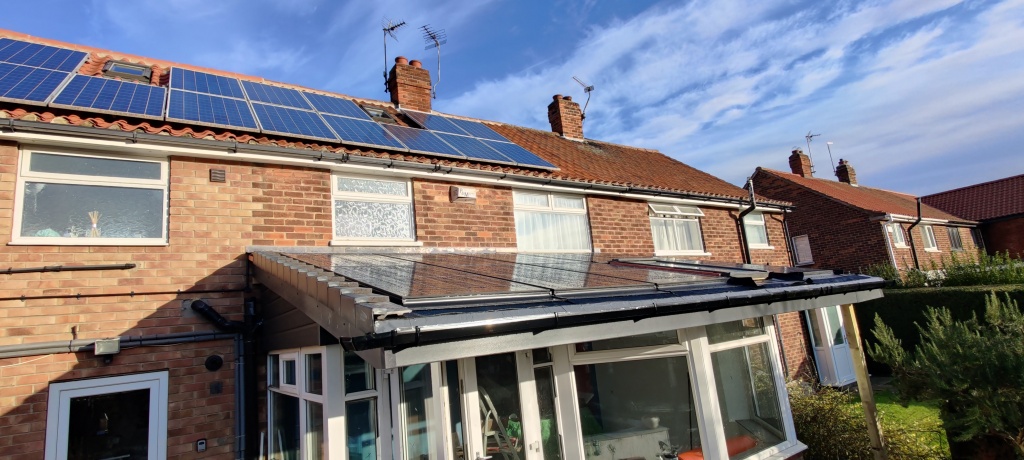
In addition to having a bigger conservatory, the solar panels absorb a lot of the summer sunlight, so the conservatory stays cooler in the summer months than would otherwise be the case. The larger roof overhang also means that we haven’t needed to install blinds. We opted for the more expensive micro-inverter technology for the panels; while we don’t suffer from shade issues that micro-inverters were designed to address, micro-inverters still optimise the system and let us monitor each panel. If a panel should fail within the 10 year guarantee we can identify it and swap it out under warranty. This system doubled our ability to generate electricity throughout the year.
It wouldn’t make great sense to add all this extra generation capacity only to export most of it. As such, a key part of the upgrade was to also add some battery storage. I’ll talk about this in detail in a future blog, but the short version is that we added a Tesla Powerwall, which provides 13.5kWh of storage (because we have a lot of panels, but also a high demand heat pump).
Energy Impacts
The important thing, however, is how the extra panels have impacted our grid consumption. This is the same chart as above but for the 2022 period, noting that we have a battery now which captures a lot of the solar generation rather than exporting it to the grid.
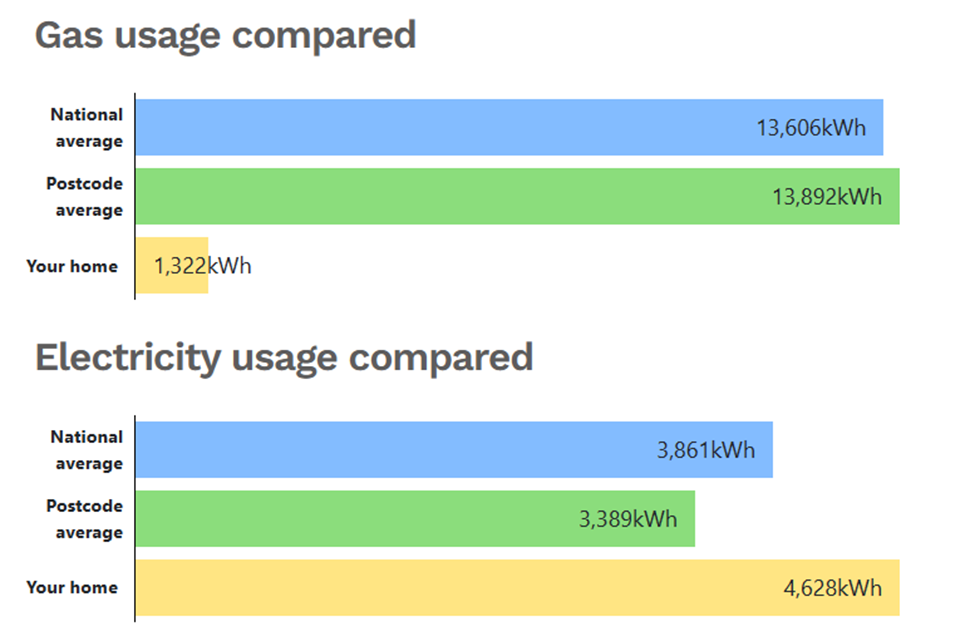
2022 Energy Impact (https://hub.carbon.coop/impact-tracker/results/14f6d695-f393-4a8f-801b-b79c224f0620/)
Our gas consumption has reduced a little; fewer baths and showers maybe, plus we tend to boil the kettle rather than turn on the hot tap since we often have free electricity; also, we swapped our gas hob for an induction hob mid-year. Our electricity is more striking, dropping by 45%. In fact, we used the same amount of in 2022 as we did in 2021, but solar took care of almost all our summer demand and the battery stored daytime generation for night time use. This pair of charts shows it really clearly:
2021 electricity imported from the grid, by month
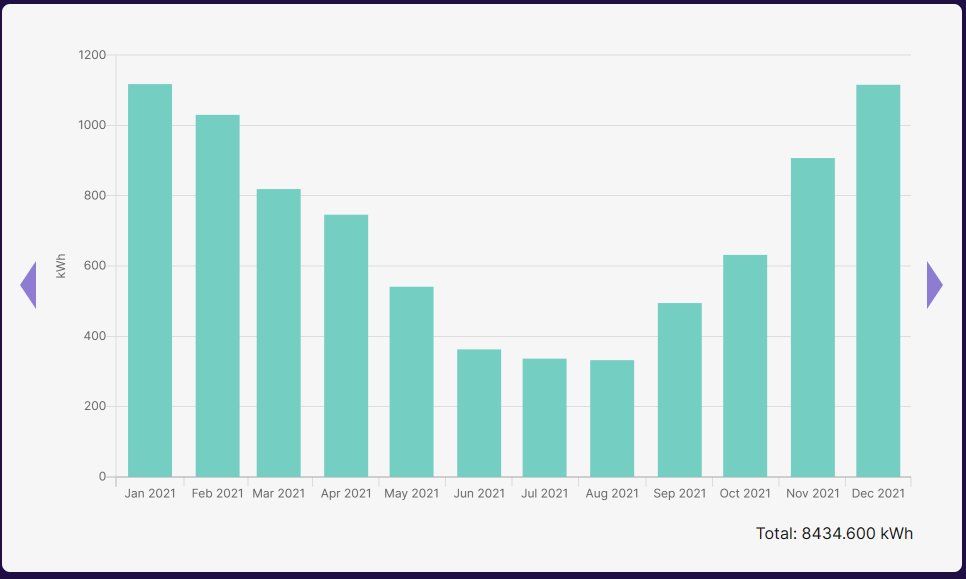
2022 electricity imported from the grid, by month
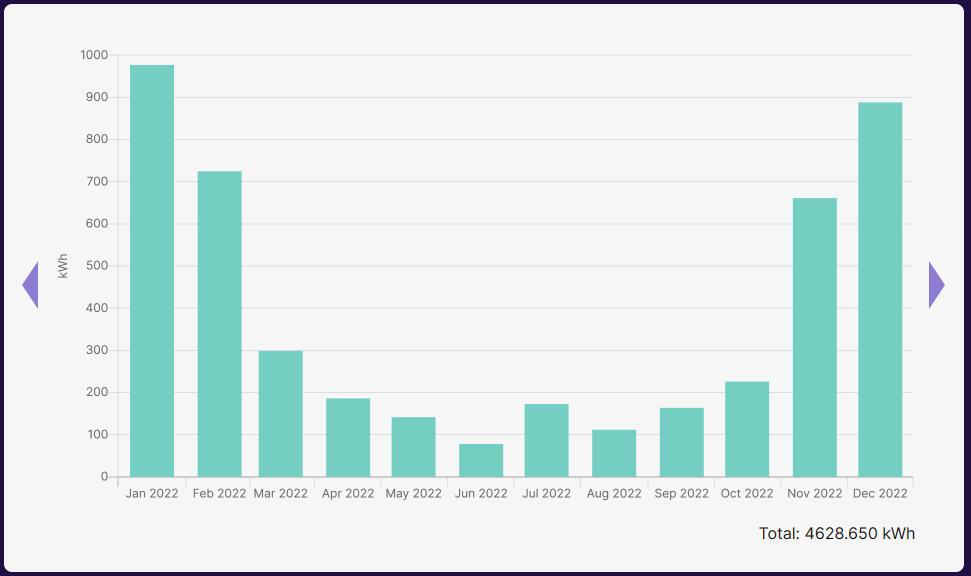
This is also striking, showing the impact of the battery, with nothing used in the wee hours once the batter is charged, and very little throughout the day as our energy is supplied by either the batter or solar:
2021 average time of use of grid electricity, by month
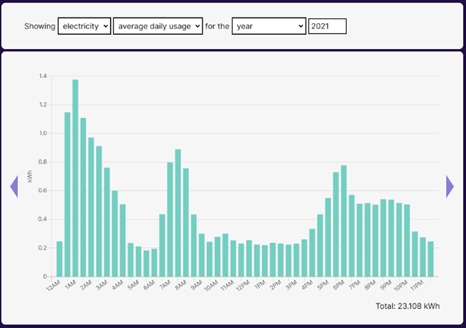
2022 average time of use of grid electricity, by month.
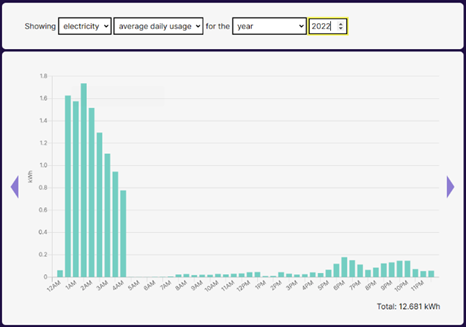
We used the same amount of electricity in 2022 as we did in 2021, but solar took care of almost all our summer demand.
Technical details
- Nominal system output: 3.0kWp
- 9 x Viridian Fusion PV16-G1 335 Watt panels, rated at 20.7% efficiency.
- Size: 1686 x 1000 mm each
- Nominal panel output: 335Wp per panel
It’s interesting to note that our old panels were rated at 16.6% efficiency, while these new ones are 20.7%; that’s a 25% increase in efficiency in a decade, which bodes well.
Return on Investment
The new panels cost £320 each, ex VAT, but including the inverter, for a total of £5,245 (+VAT) for the system, excluding fitting. These are some of the more expensive panels and the fitting was complex in this case. A 3 – 4 kW system can be installed starting at around £5k – £6k and can be expected to generate 3 – 4 MWh of electricity each year.
If electricity prices remain high (upwards of £0.35 per kWh) then the theoretical reduction in your electricity bill could be around £1200 per year, giving an exciting breakeven time of 5 years. In reality, you will probably only use 50% of what you generate, with the rest going to the grid. You will be paid for that, with the amount depending on your electricity supplier. There is a fairly up to date table of rates here: https://solarenergyuk.org/resource/smart-export-guarantee/ though you may find other / better rates. The best you can expect, unless you have a Tesla Powerwall, is about 5p/kWh. On this basis you are looking at around £600 from the electricity you don’t have to buy and a measly £90 for the other £600 worth of electricity you export. You are then looking at a payback time of around 9 years, maybe less if electricity goes up further. On the other hand, your panels will keep working long after the breakeven point and you can expect your ~£6k investment to provide £22k over 25 years, which I think is equivalent to 5% interest per annum; much, much better than bank or ISA rates (but I’m not a finance expert, so tell me if I am wrong).
Alternatively, you could invest another £5k – £10k in a battery and use much more of what you generate like we do. More on that in the next blog.
Equally importantly, we have massively reduced our carbon footprint. The second system resulted in a 40% decrease in our household CO2; well over a tonne per year.

Conclusion
Once again, we got lucky with our timing. We spent a chunk of capital on doubling the size of our system, hitting the sweet spot of over 5kWp and doubling our generation. We did this almost a year in advance of the energy crisis, which has made it much less painful than for others less fortunate/farsighted than us. Combining the upgrade with the need to fix our conservatory roof offset some of the cost of each and resulted in a substantial improvement to our conservatory living space.
Next time, domestic batteries.


One reply on “Pre-empting the energy crisis”
[…] Pre-empting the energy crisis 09/01/2023 […]